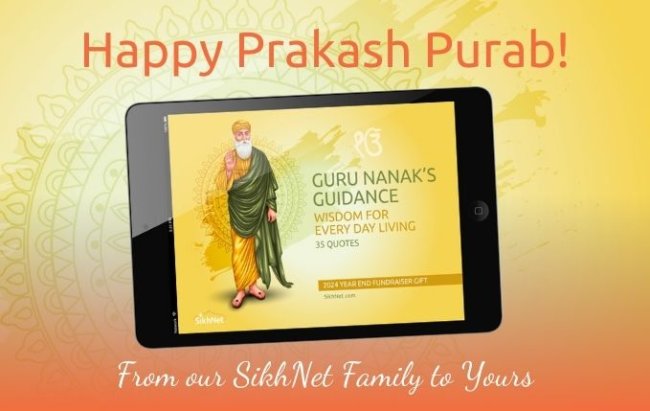Part 3: Ho Gosaee Da Pehilvaanra
Throughout part three, I turn to primarily one Shabad for Guru’s guidance and instruction. Intermittently, I have included parts of Shabad from other sections such as Jap Ji Sahib to support an understanding and develop connections for the reader.
In terms of how everything has been framed, a reader of parts one and two might conclude that I am not being faithful to my Guru either. The entire story, the experiences, the discussions, have been focused on some form of “me” and “other”, “us” and them” and the qualification of “other” as enemy. This observation of my unfaithfulness is perfectly correct and any criticisms that follow this observation would be wholly founded.
I would like to provide some justification for this framing: first, I had to be honest about my actual experiences and attitudes. I did view things in terms of “us” and “them.” My perspective has since changed. Second, in order to arrive at understanding the need to trust the Guru and turn to the Guru, I had to explicitly identify the terms in which we, as a community, indeed are not responding from a Guru-centered perspective. Hence, baby steps. The next step is turning to the Guru.
One can argue all the nuances of the definition of a Sikh, but one element will always be true. A Sikh is one who wholly places his or her trust in the Guru to guide one through life’s hurdles and ultimately to the experience of Sach Khand. One can have all of the kesh (hair) and baana (uniform) one wants. One may even look like an exact living replica of Guru Gobind Singh Ji. Nevertheless, if there is no trust in the Guru, then there is no Sikh. Sach Khand, then, is not an other-worldly experience, but an enlightened experience of the present reality. So how do we arrive at this enlightened experience and perspective?
First, trust.
ਸਿਰੀਰਾਗੁ ਮਹਲਾ ੫ ॥
ਪੈ ਪਾਇ ਮਨਾਈ ਸੋਇ ਜੀਉ ॥
ਸਤਿਗੁਰ ਪੁਰਖਿ ਮਿਲਾਇਆ ਤਿਸੁ ਜੇਵਡੁ ਅਵਰੁ ਨ ਕੋਇ ਜੀਉ ॥੧॥ ਰਹਾਉ ॥
ਗੋਸਾਈ ਮਿਹੰਡਾ ਇਠੜਾ ॥
ਅੰਮ ਅਬੇ ਥਾਵਹੁ ਮਿਠੜਾ ॥
ਭੈਣ ਭਾਈ ਸਭਿ ਸਜਣਾ ਤੁਧੁ ਜੇਹਾ ਨਾਹੀ ਕੋਇ ਜੀਉ ॥੧॥
Falling at the feet, I attempt to appease the Beloved.
The True Guru united me with the Primal One. There is none greater than the One. |Reflect|
The Master of the Universe is my desire.
[The One] is dearer than my mother and father.
Sister, brother, all friends, You are unlike anyone, Beloved. ॥1॥
Trusting the Guru means trusting one’s life, one’s soul in the hands of the Guru. Not one’s mother. Not one’s father. Not one’s friends, nor one’s family. Trusting the Guru means trusting the Guru’s Word and no one else’s. Trusting the Guru means first trusting Shabad Guru — Guru Granth Sahib Ji.
Guru Sahib continuously reminds us of the necessity to trust Shabad Guru:
ਬਾਣੀ ਗੁਰੂ ਗੁਰੂ ਹੈ ਬਾਣੀ ਵਿਚਿ ਬਾਣੀ ਅੰਮ੍ਰਿਤੁ ਸਾਰੇ ॥
ਗੁਰੁ ਬਾਣੀ ਕਹੈ ਸੇਵਕੁ ਜਨੁ ਮਾਨੈ ਪਰਤਖਿ ਗੁਰੂ ਨਿਸਤਾਰੇ ॥੫॥
Word is Guru. Guru is Word. Within the Word lies the sweetest treasure [Beloved — Ik Oankar].
The Guru speaks (through the Word). The servant trusts and acts accordingly. The Guru guides and liberates [the servant]. ॥5॥
(Guru Raam Daas Ji — Sri Guru Granth Sahib Ji — Ang 982)
As the Sikh trusts the Guru, the Sikh follows the instruction of the Guru (hukam), and sets out on a path of Truth.
ਤੇਰੈ ਹੁਕਮੇ ਸਾਵਣੁ ਆਇਆ ॥
ਮੈ ਸਤ ਕਾ ਹਲੁ ਜੋਆਇਆ ॥
ਨਾਉ ਬੀਜਣ ਲਗਾ ਆਸ ਕਰਿ ਹਰਿ ਬੋਹਲ ਬਖਸ ਜਮਾਇ ਜੀਉ ॥੨॥
Through your instruction, comes the rainy season (of Naam).
Within my self, I have prepared the plow instrument of truth.
Planting the seeds of Naam, I hope to gather a heap of your Grace. ॥2॥
Living a life of truth, the Sikh’s life and mind are guided by the seeds of Naam. The Sikh comes to realize only the One exists. There is no other. There is no white. There is no brown. There is no enemy. There is just the One. Hence, all effort is placed in following the One’s instruction.
ਹਉ ਗੁਰ ਮਿਲਿ ਇਕੁ ਪਛਾਣਦਾ ॥
ਦੁਯਾ ਕਾਗਲੁ ਚਿਤਿ ਨ ਜਾਣਦਾ ॥
ਹਰਿ ਇਕਤੈ ਕਾਰੈ ਲਾਇਓਨੁ ਜਿਉ ਭਾਵੈ ਤਿਂਵੈ ਨਿਬਾਹਿ ਜੀਉ ॥੩॥
Meeting the Guru, I recognize the One.
I do not know another path, another entity.
The One has tasked me to One’s work. As One desires, my mind obeys the One. ॥3॥
In performing the acts of the One, the Sikh is robed with honor from the One. The Sikh becomes a master of his/her self, taking the five (5) rivals (Kam — desire, Krodh — anger, Lobh — greed, Moh — attachment, Ahankar — ego) as prisoners. In doing so, the Sikh encourages all others to also follow the path of the Guru, and enjoy the harvest of Naam.
ਤੁਸੀ ਭੋਗਿਹੁ ਭੁੰਚਹੁ ਭਾਈਹੋ ॥
ਗੁਰਿ ਦੀਬਾਣਿ ਕਵਾਇ ਪੈਨਾਈਓ ॥
ਹਉ ਹੋਆ ਮਾਹਰੁ ਪਿੰਡ ਦਾ ਬੰਨਿ ਆਦੇ ਪੰਜਿ ਸਰੀਕ ਜੀਉ ॥੪॥
Siblings, come enjoy this food (the harvest of Naam).
In the Guru’s court, the Guru has robed me with honor.
I have become the master of my body (self). I have taken as prisoner the five rivals of the self. ॥4॥
All of what I shared thus far, through exploring Gurbani, are concepts that are or should be common Sikh knowledge about the nature of Sikhi. Trust the Guru. Follow the instructions of the Guru (Shabad). In doing so, conquer the self.
So why am I writing this? Because it is apparent that we do not actually follow this mode of action. When a critical event happens in our individual or communal lives, we rarely turn to the Guru to understand how the Guru would respond. We turn to our friends. We turn to what our parents or grandparents say or have said in the past. We turn to our siblings and relatives. We are influenced by our relationships with friends, family, and society. We unfortunately are not as much influenced by the Guru. At most, we might seek others’ knowledge of Gurbani rather than turning to the Guru ourselves.
What does the Guru say about where the Guru turns?
ਹਉ ਆਇਆ ਸਾਮੈ੍ ਤਿਹੰਡੀਆ ॥
ਪੰਜਿ ਕਿਰਸਾਣ ਮੁਜੇਰੇ ਮਿਹਡਿਆ ॥
ਕੰਨੁ ਕੋਈ ਕਢਿ ਨ ਹੰਘਈ ਨਾਨਕ ਵੁਠਾ ਘੁਘਿ ਗਿਰਾਉ ਜੀਉ ॥੫॥
I have come to the Sanctuary of the One.
The five (previously rivals) are my farm hands.
None (of the five) dare oppose me. Nanak says, my village (self) is prosperous (connected to the One). ॥5॥
Just as the Guru turns to the Sanctuary of the One, so must Sikhs through their connection to Shabad Guru.
ਪਉੜੀ ॥
ਹਰਿ ਜੀਉ ਸਚਾ ਸਚੁ ਹੈ ਸਚੀ ਗੁਰਬਾਣੀ ॥
ਸਤਿਗੁਰ ਤੇ ਸਚੁ ਪਛਾਣੀਐ ਸਚਿ ਸਹਜਿ ਸਮਾਣੀ ॥
ਅਨਦਿਨੁ ਜਾਗਹਿ ਨਾ ਸਵਹਿ ਜਾਗਤ ਰੈਣਿ ਵਿਹਾਣੀ ॥
ਗੁਰਮਤੀ ਹਰਿ ਰਸੁ ਚਾਖਿਆ ਸੇ ਪੁੰਨ ਪਰਾਣੀ ॥
ਬਿਨੁ ਗੁਰ ਕਿਨੈ ਨ ਪਾਇਓ ਪਚਿ ਮੁਏ ਅਜਾਣੀ ॥੧੭॥
Beloved One is forever true; the Guru’s speech is of the One.
Through the True Guru, Truth is realized, and one is easily absorbed into the True One.
Night and day, they remain aware, and (their conscience) does not sleep; they live out their lives in awareness.
Those who have tasted Guru-consciousness in their lives are the most exalted.
Without the Guru, the One is not realized; Those who do not come to know the Guru rot and die (waste the opportunity of their life). ॥17॥
(Guru Amar Daas Ji — Sri Guru Granth Sahib Ji — Ang 515)
As Pauri 5 instructed us above, following the Guru’s path, the five, which were previously rivals, and often Christianized as “vices,” no longer remain rivals or vices. They become the farm hands on one’s land (the self). Kam, Krodh, Lobh, Moh, Ahankaar are not evil, but if once properly controlled and channeled through Guru-Wisdom, actually help cultivate the field of Naam and lead the Sikh towards Truth (Sach Khand).
The Sikh only achieves this level of clarity and success in life when the Sikh focuses on Shabad Guru. With this focus, the Sikh experiences the Grace of One forever within one’s presence, as if the Hand of Ik is on their forehead. This leads to a comfort, confidence, satisfaction, and success that is unparalleled.
ਮੈ ਸੁਖੀ ਹੂੰ ਸੁਖੁ ਪਾਇਆ ॥
ਗੁਰਿ ਅੰਤਰਿ ਸਬਦੁ ਵਸਾਇਆ ॥
ਸਤਿਗੁਰਿ ਪੁਰਖਿ ਵਿਖਾਲਿਆ ਮਸਤਕਿ ਧਰਿ ਕੈ ਹਥੁ ਜੀਉ ॥੯॥
I have obtained the comfort of comforts.
The Guru has implanted the Word of the Shabad deep within me.
The True Guru has shown me the Primal One; the Guru’s hand is planted upon my forehead. ||9||
With a Shabad focused mindset, the Sikhs seeks the company of other Sikhs of the Guru. It is in their company that the Home of Righteous Truth is found. Once in that company, the Sikh’s mentality is filled with immense humility, seeking to express a reverence and awe for their being.
ਮੈ ਬਧੀ ਸਚੁ ਧਰਮ ਸਾਲ ਹੈ ॥
ਗੁਰਸਿਖਾ ਲਹਦਾ ਭਾਲਿ ਕੈ ॥
ਪੈਰ ਧੋਵਾ ਪਖਾ ਫੇਰਦਾ ਤਿਸੁ ਨਿਵਿ ਨਿਵਿ ਲਗਾ ਪਾਇ ਜੀਉ ॥੧੦॥
I have attached myself to the Home of Righteous Truth.
With effort, I find the (company of) the Guru’s Sikhs.
I wash their feet, and wave the fan over them. Bowing lower and lower (with humility), I fall at their feet. ||10||
The company of the Sikhs is sought because it is within that company, in their dialogue and discussion, that the Guru is found. It is through that company of the Sikhs that the Guru’s instruction and solution for problems is found. Those following the Guru’s instruction, board the Boat of Truth and are liberated from the trials and tribulations of the world.
ਸੁਣਿ ਗਲਾ ਗੁਰ ਪਹਿ ਆਇਆ ॥
ਨਾਮੁ ਦਾਨੁ ਇਸਨਾਨੁ ਦਿੜਾਇਆ ॥
ਸਭੁ ਮੁਕਤੁ ਹੋਆ ਸੈਸਾਰੜਾ ਨਾਨਕ ਸਚੀ ਬੇੜੀ ਚਾੜਿ ਜੀਉ ॥੧੧॥
I heard of the Guru, and so I went to the Guru.
Naam, the goodness of sharing, and true cleansing were (the instructions that were) affirmed (in the mind).
All are liberated from the world (trials and tribulations of), Nanak says those that board the Boat of Truth. ॥11॥
Once one begins to trust the Guru and turn to saadh sangat for Guru-centered guidance, the instructions received from the Guru are those of Naam, Daan, and Isnaan. Naam is the continual imbibing of Shabad Guru in one’s life, in all aspects from thoughts and feelings, to actions. Daan is the expression of carefree sharing of the gifts of the harvest of Naam. This, unfortunately, is short changed and Christianized as “charity.” Charity is only one aspect and often Sikhs only interpret this as the practice of Langar.
Daan is ultimately the sharing of Guru’s Mat (conscience). Expression of Daan can be found in a myriad of ways. From Bhai Ghanaiya’s healing of the wounded in the fields of battle to Bhagat Puran Singh’s creation of a home for those forgotten and abused by society to Khalsa’s physical fight to protect the oppressed and downtrodden. All are expressions of Daan. Daan is the creative action inspired by Naam; Karta Purakh — Nirbhau, Nirvair. Daan is the eternal giving of oneself in the name of Ik Oankar, until a distinction between the self and the One no longer remains.
Isnaan, then, is the continual reflection of one’s actions to ensure that the mind is continually cleansed of duality, focused on Ik, and filled with empathy. In our individual lives, isnaan is practiced through simran (meditation) and nitnem (daily prayer), and through our engagement with Sangat. Isnaan is not simply a cleansing but a flushing of the mind and spirit.
What I have discussed above is the life of a Shabad-inspired Sikh, whose life values and actions are a mirror of Mool Mantar. Let us come back now and reflect on the activity that we are currently engaged in.
We have created numerous organizations, efforts, and individual activities that are focused on solving problems. In all of these efforts, have we sought the viewpoint of the Guru, or the company of Sikhs, which would lead us to an actual solution? Or have we simply behaved in a paternalistic manner, believing that our education, our money, our following, our status is the right one, the one with the correct perspective that others need to follow?
In the communal life, Isnaan is practiced through consensus. When Sikhs, individuals who practice isnaan in their daily lives, engage in discussion, the collective consciousness takes the form of Guru’s Mat (Guru-consciousness). Hence, decisions that arose from consensus based decision making were called Gurmattas. So, then, what would we call decisions made on behalf of all Sikhs that are not based on consensus? Manmat?
Humility in our action would cause us to speak and listen with humility to one another, to build consensus. Instead, what we have is five gurdwaras every 10 square miles and 10 organizations for the same one problem. Our behavior is best described as in the Jap Ji when Guru Nanak Sahib says:
ਨਾਨਕ ਆਖਣਿ ਸਭੁ ਕੋ ਆਖੈ ਇਕ ਦੂ ਇਕੁ ਸਿਆਣਾ ॥
O Nanak, everyone speaks of Truth, each one wiser than the rest.
(Guru Nanak Sahib — Sri Guru Granth Sahib Ji — Ang 4)
The world is watching Khalsa Ji, both the interior and exterior world, at how we behave. At how we react. At what ultimately controls our essence, our being. Are we Shabad inspired?
Become the wrestlers and warriors of the One. The true Akaal Purakh Ki Fauj.
ਹਉ ਗੋਸਾਈ ਦਾ ਪਹਿਲਵਾਨੜਾ ॥
ਮੈ ਗੁਰ ਮਿਲਿ ਉਚ ਦੁਮਾਲੜਾ ॥
ਸਭ ਹੋਈ ਛਿੰਝ ਇਕਠੀਆ ਦਯੁ ਬੈਠਾ ਵੇਖੈ ਆਪਿ ਜੀਉ ॥੧੭॥
I am a wrestler; I belong to the Master of the Universe.
I, having met the Guru, have tied a tall, plumed turban.
All have gathered to watch the wrestling match, and the One Itself is seated to behold it. ||17||
Let us shed our egos, and seek consensus. Shed the shackles of the various classifications of society (varnas), of the educated and uneducated, of Jatt and Bhaapa, of white and brown, of colonizer and colonized, of us and them.
ਤੂੰ ਵਰਨਾ ਚਿਹਨਾ ਬਾਹਰਾ ॥
ਹਰਿ ਦਿਸਹਿ ਹਾਜਰੁ ਜਾਹਰਾ ॥
ਸੁਣਿ ਸੁਣਿ ਤੁਝੈ ਧਿਆਇਦੇ ਤੇਰੇ ਭਗਤ ਰਤੇ ਗੁਣਤਾਸੁ ਜੀਉ ॥੨੦॥
You are without color, without classification or mark.
The One is seen to be manifest and present (within everyone and everything).
Hearing your praises again and again (in everything), your devotees focus on you. ||20||
In 1699, we were amazed when Guru Gobind Singh Ji bowed to his Sikhs and we sung praises “vaho vaho Gobind Singh ape gur chela.” So why, today, are we all trying to be the Guru of all Sikhs (behaving as though we know what is best) and not being the chele? Where is the reverence for one another? The desire to revere fellow Sikhs through washing of feet and fanning them.
If we are to find solutions to the problems that confront us, then it can only be done by trust in the Guru and trust in one another. With Shabad inspired thought and behavior, humility in our hearts, we can build consensus. This is not a novel concept. It has been done before. We need to do it again.
This is my suggestion for you Khalsa Ji: work toward consensus. Work toward a Sarbat Khalsa modus operandi. What is a Sarbat Khalsa way of operation? How should it work? These are discussions for you to have with yourself (read literature), your Guru (Gurbani), and your local, state, national, and global Sangat (Guru Panth).
We are moving increasingly toward a globalized society. What happens in Houston, TX, USA will inevitably have an impact on what happens in London, UK. Hence, our policies, procedures, actions, all need to be made with careful consideration of Gurmat that can only be achieved through consensus.
Do not capitalize on Sikhi. Capital does not make right. Often, organizations convince themselves that what they are doing is correct because enough Sikh capital is supporting them. Are they not representing the Sikh view point, when all of these people (majoritarianism) and all of this money is in support of their cause? Capitalism is not necessarily in conflict with Sikhi, but the capitalization of Sikhi is in direct conflict with Gurmat.
When consensus is not reached, voices that are quelled are robbed of their righteous representation. The Dastar does not belong to whoever has the highest education, the most money, or the greatest social status. It belongs to those who have wholly placed their trust in the Guru, devoted themselves to the Guru. Hence, the identity of the Sikhs belongs to all Sikhs. Sikh representation must be arrived at through consensus.
In Guru Nanak’s time, there was a man who was the chief of his village, Malik Bhago, who became wealthy by taking the crop of his fellow villagers and making them starve. Sikhi is the village to which all Sikhs belong. Identities, representations, philosophies, policies, procedures: these are the crops of that village. When an individual or organization seeks to agglomerate these crops at the expense of all the rest of the villagers, to whom these crops also belong, that individual or organization in essence reenacts the story of Malik Bhago. Guru is attracted to Naam. Naam is what must cultivate these crops. The only way to figure out how to have Naam cultivate these crops is to have consensus through Sangat.
ਜਿਨ ਹਰਿ ਜਨ ਸਤਿਗੁਰ ਸੰਗਤਿ ਪਾਈ ਤਿਨ ਧੁਰਿ ਮਸਤਕਿ ਲਿਖਿਆ ਲਿਖਾਸਿ ॥
ਧਨੁ ਧੰਨੁ ਸਤਸੰਗਤਿ ਜਿਤੁ ਹਰਿ ਰਸੁ ਪਾਇਆ ਮਿਲਿ ਜਨ ਨਾਨਕ ਨਾਮੁ ਪਰਗਾਸਿ ॥੪॥੪॥
(Guru Raam Daas Ji — Sri Guru Granth Sahib Ji — Ang 10)
Those servants of the One who have attained the company of the true Guru, they have good destiny pre-written on their forehead.
Blessed, blessed is the Sat Sangat, the True Congregation, where the One’s Love is obtained; where meeting with the One’s servants (devotees), O Nanak, the Light of the Naam shines forth. ||4||4||
It is quintessential to the Sikh experience that Sat Sangat be sought, because it is in the Sat Sangat that Naam is essentially experienced. It is in Sat Sangat that the Guru liberates the Sikh.
ਮੈ ਜੁਗਿ ਜੁਗਿ ਦਯੈ ਸੇਵੜੀ ॥
ਗੁਰਿ ਕਟੀ ਮਿਹਡੀ ਜੇਵੜੀ ॥
ਹਉ ਬਾਹੁੜਿ ਛਿੰਝ ਨ ਨਚਊ ਨਾਨਕ ਅਉਸਰੁ ਲਧਾ ਭਾਲਿ ਜੀਉ ॥੨੧॥੨॥੨੯॥
I am forever the servant of the One.
The Guru has cut my bonds (from problems of the world, of existence).
I shall not have to dance in the wrestling arena of life again. Nanak has searched, and found this opportunity. ||21||2||29||
Finally, outside of a model of Shabad focused consensus, an over-dependence on academics, experts, and organizations will mislead the Sikhs, perpetuate the present problems and create new unnecessary ones. Far too often, intellectuals find themselves obsessed in the minefields of history and the specializations of their field, losing their connection to the present reality. Our mindset, our dialogue, needs to be Shabad focused and Guru inspired, which necessarily requires the involvement of all Sikhs, with all variations of specialities and non-specialities.
Let us remember that it is the humblest of Sikhs that the Guru blessed with Grace and who became the Guru’s heroes, whose feet the Guru sought to become the dust of and whose company the Guru sought. Become humble. Shed the ego of intellect. Seek the company of the Sikhs, locally, state-wide, nation-wide, globally. Build consensus at all levels, through Shabad focused mindset and dialogue.
ਜਨੁ ਨਾਨਕੁ ਧੂੜਿ ਮੰਗੈ ਤਿਸੁ ਗੁਰਸਿਖ ਕੀ ਜੋ ਆਪਿ ਜਪੈ ਅਵਰਹ ਨਾਮੁ ਜਪਾਵੈ ॥੨॥
Servant Nanak begs for the dust of the feet of that GurSikh, who chants the Naam, and inspires others to chant it. ||2||
(Guru Raam Daas Ji — Sri Guru Granth Sahib Ji — Ang 305)
Please forgive me for any mistake or oversight,
Waheguru Ji Ka Khalsa,
Waheguru Ji Ki Fateh!
Note: It is the author’s humble request to be made aware of any mistakes that are found in terms of Gurmat, whether in the process of translation of Gurbani or otherwise in the writing.
Throughout the translations there was a consistent effort to remove the usages of Him, His, or Lord; these usages are not compatible with the instances of Ik Oankar in Gurbani.
With regards to the English translations of Gurbani used throughout the three parts to this essay, they were done according to the following process: 1) an analysis of Mahan Kosh for terms used in each Shabad, 2) coming up with the author’s own translation using the Mahan Kosh definitions and 3) then comparing it to the english translation by Dr Sant Singh Khalsa and the punjabi translation by Professor Sahib Singh. Professor Sahib Singh translations were given a preference whenever a serious conflict occurred. At times the translations by Dr. Sant Singh Khalsa were used almost entirely unmodified as they were found to be sufficiently consistent with Mahan Kosh definitions and Prof. Sahib Singh’s translation.
ਤੂ ਸਮਰਥੁ ਵਡਾ ਮੇਰੀ ਮਤਿ ਥੋਰੀ ਰਾਮ ॥
Oh One, You are great and all-powerful; my understanding is inadequate.
(Guru Arjan Sahib — Sri Guru Granth Sahib Ji — Ang 547)




